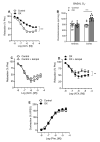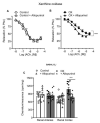Hyperoxaluria Induces Endothelial Dysfunction in Preglomerular Arteries: Involvement of Oxidative Stress
- PMID: 35954150
- PMCID: PMC9367519
- DOI: 10.3390/cells11152306
Hyperoxaluria Induces Endothelial Dysfunction in Preglomerular Arteries: Involvement of Oxidative Stress
Abstract
Urolithiasis is a worldwide problem and a risk factor for kidney injury. Oxidative stress-associated renal endothelial dysfunction secondary to urolithiasis could be a key pathogenic factor, similar to obesity and diabetes-related nephropathy. The aim of the present study was to characterize urolithiasis-related endothelial dysfunction in a hyperoxaluria rat model of renal lithiasis.
Experimental approach: Endothelial dysfunction was assessed in preglomerular arteries isolated from control rats and in which 0.75% ethylene glycol was administered in drinking water. Renal interlobar arteries were mounted in microvascular myographs for functional studies; superoxide generation was measured by chemiluminescence and mRNA and protein expression by RT-PCR and immunofluorescence, respectively. Selective inhibitors were used to study the influence of the different ROS sources, xanthine oxidase, COX-2, Nox1, Nox2 and Nox4. Inflammatory vascular response was also studied by measuring the RNAm expression of NF-κB, MCP-1 and TNFα by RT-PCR.
Results: Endothelium-dependent vasodilator responses were impaired in the preglomerular arteries of the hyperoxaluric group along with higher superoxide generation in the renal cortex and vascular inflammation developed by MCP-1 and promoted by NF-κB. The xanthine oxidase inhibitor allopurinol restored the endothelial relaxations and returned superoxide generation to basal values. Nox1 and Nox2 mRNA were up-regulated in arteries from the hyperoxaluric group, and Nox1 and Nox2 selective inhibitors also restored the impaired vasodilator responses and normalized NADPH oxidase-dependent higher superoxide values of renal cortex from the hyperoxaluric group.
Conclusions: The current data support that hyperoxaluria induces oxidative stress-mediated endothelial dysfunction and inflammatory response in renal preglomerular arteries which is promoted by the xanthine oxidase, Nox1 and Nox2 pathways.
Keywords: endothelial dysfunction; oxidative stress; urolithiasis.
Conflict of interest statement
The authors declare no conflict of interest.
Figures







Similar articles
-
Differential contribution of Nox1, Nox2 and Nox4 to kidney vascular oxidative stress and endothelial dysfunction in obesity.Redox Biol. 2020 Jan;28:101330. doi: 10.1016/j.redox.2019.101330. Epub 2019 Sep 20. Redox Biol. 2020. PMID: 31563085 Free PMC article.
-
Nox1-derived oxidative stress as a common pathogenic link between obesity and hyperoxaluria-related kidney injury.Urolithiasis. 2020 Dec;48(6):481-492. doi: 10.1007/s00240-019-01170-w. Epub 2019 Nov 5. Urolithiasis. 2020. PMID: 31690958
-
Hydrogen peroxide derived from NADPH oxidase 4- and 2 contributes to the endothelium-dependent vasodilatation of intrarenal arteries.Redox Biol. 2018 Oct;19:92-104. doi: 10.1016/j.redox.2018.08.004. Epub 2018 Aug 7. Redox Biol. 2018. PMID: 30125808 Free PMC article.
-
NADPH oxidases, reactive oxygen species, and hypertension: clinical implications and therapeutic possibilities.Diabetes Care. 2008 Feb;31 Suppl 2:S170-80. doi: 10.2337/dc08-s247. Diabetes Care. 2008. PMID: 18227481 Review.
-
Endothelial Dysfunction: An Intermediate Clinical Feature between Urolithiasis and Cardiovascular Diseases.Int J Mol Sci. 2022 Jan 14;23(2):912. doi: 10.3390/ijms23020912. Int J Mol Sci. 2022. PMID: 35055099 Free PMC article. Review.
Cited by
-
Cardiovascular and Cerebrovascular Morbidity in Patients with Urolithiasis: An Epidemiological Approach Based on Hospitalization Burden Data from 1997 to 2021.J Clin Med. 2024 Jun 18;13(12):3564. doi: 10.3390/jcm13123564. J Clin Med. 2024. PMID: 38930093 Free PMC article.
-
COVID-19 Causes Ferroptosis and Oxidative Stress in Human Endothelial Cells.Antioxidants (Basel). 2023 Jan 31;12(2):326. doi: 10.3390/antiox12020326. Antioxidants (Basel). 2023. PMID: 36829885 Free PMC article.
-
Impact of Obesity on Hospitalization Burden of Urolithiasis in Spain Between 1997 and 2021.J Clin Med. 2025 Jan 9;14(2):381. doi: 10.3390/jcm14020381. J Clin Med. 2025. PMID: 39860386 Free PMC article.
References
-
- de Vries A.P., Ruggenenti P., Ruan X.Z., Praga M., Cruzado J.M., Bajema I.M., D’Agati V.D., Lamb H.J., Barlovic D.P., Hojs R., et al. Fatty kidney: Emerging role of ectopic lipid in obesity-related renal disease. Lancet Diabetes Endocrinol. 2014;2:417–426. doi: 10.1016/S2213-8587(14)70065-8. - DOI - PubMed
Publication types
MeSH terms
Substances
LinkOut - more resources
Full Text Sources
Research Materials
Miscellaneous

